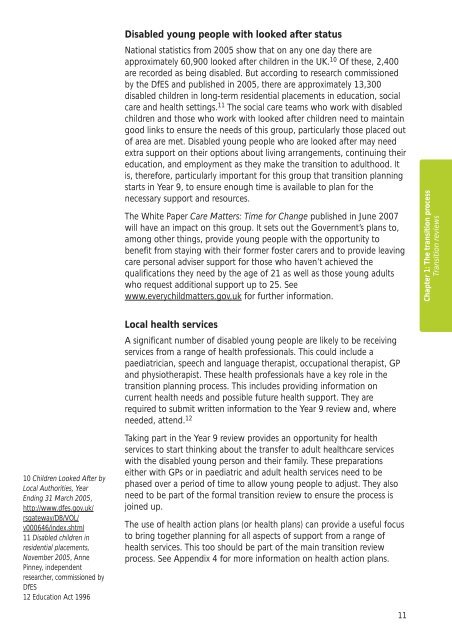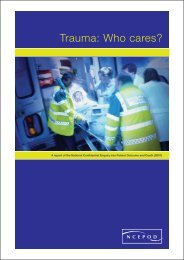A Transition Guide for All Services - Transition Information Network
A Transition Guide for All Services - Transition Information Network
A Transition Guide for All Services - Transition Information Network
- No tags were found...
You also want an ePaper? Increase the reach of your titles
YUMPU automatically turns print PDFs into web optimized ePapers that Google loves.
Disabled young people with looked after statusNational statistics from 2005 show that on any one day there areapproximately 60,900 looked after children in the UK. 10 Of these, 2,400are recorded as being disabled. But according to research commissionedby the DfES and published in 2005, there are approximately 13,300disabled children in long-term residential placements in education, socialcare and health settings. 11 The social care teams who work with disabledchildren and those who work with looked after children need to maintaingood links to ensure the needs of this group, particularly those placed outof area are met. Disabled young people who are looked after may needextra support on their options about living arrangements, continuing theireducation, and employment as they make the transition to adulthood. Itis, there<strong>for</strong>e, particularly important <strong>for</strong> this group that transition planningstarts in Year 9, to ensure enough time is available to plan <strong>for</strong> thenecessary support and resources.The White Paper Care Matters: Time <strong>for</strong> Change published in June 2007will have an impact on this group. It sets out the Government’s plans to,among other things, provide young people with the opportunity tobenefit from staying with their <strong>for</strong>mer foster carers and to provide leavingcare personal adviser support <strong>for</strong> those who haven’t achieved thequalifications they need by the age of 21 as well as those young adultswho request additional support up to 25. Seewww.everychildmatters.gov.uk <strong>for</strong> further in<strong>for</strong>mation.Chapter 1: The transition process<strong>Transition</strong> reviewsLocal health servicesA significant number of disabled young people are likely to be receivingservices from a range of health professionals. This could include apaediatrician, speech and language therapist, occupational therapist, GPand physiotherapist. These health professionals have a key role in thetransition planning process. This includes providing in<strong>for</strong>mation oncurrent health needs and possible future health support. They arerequired to submit written in<strong>for</strong>mation to the Year 9 review and, whereneeded, attend. 1210 Children Looked After byLocal Authorities, YearEnding 31 March 2005,http://www.dfes.gov.uk/rsgateway/DB/VOL/v000646/index.shtml11 Disabled children inresidential placements,November 2005, AnnePinney, independentresearcher, commissioned byDfES12 Education Act 1996Taking part in the Year 9 review provides an opportunity <strong>for</strong> healthservices to start thinking about the transfer to adult healthcare serviceswith the disabled young person and their family. These preparationseither with GPs or in paediatric and adult health services need to bephased over a period of time to allow young people to adjust. They alsoneed to be part of the <strong>for</strong>mal transition review to ensure the process isjoined up.The use of health action plans (or health plans) can provide a useful focusto bring together planning <strong>for</strong> all aspects of support from a range ofhealth services. This too should be part of the main transition reviewprocess. See Appendix 4 <strong>for</strong> more in<strong>for</strong>mation on health action plans.11
















